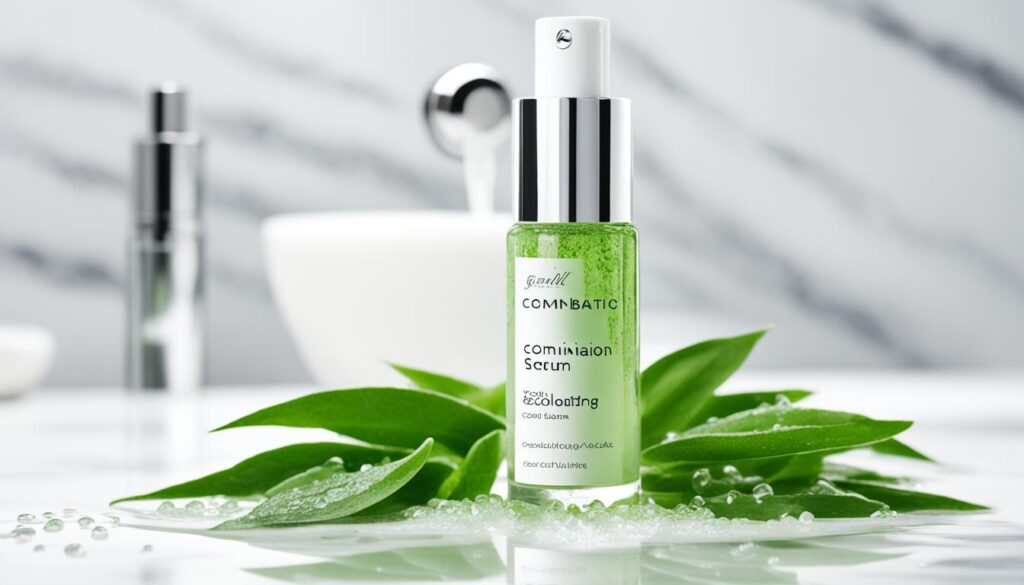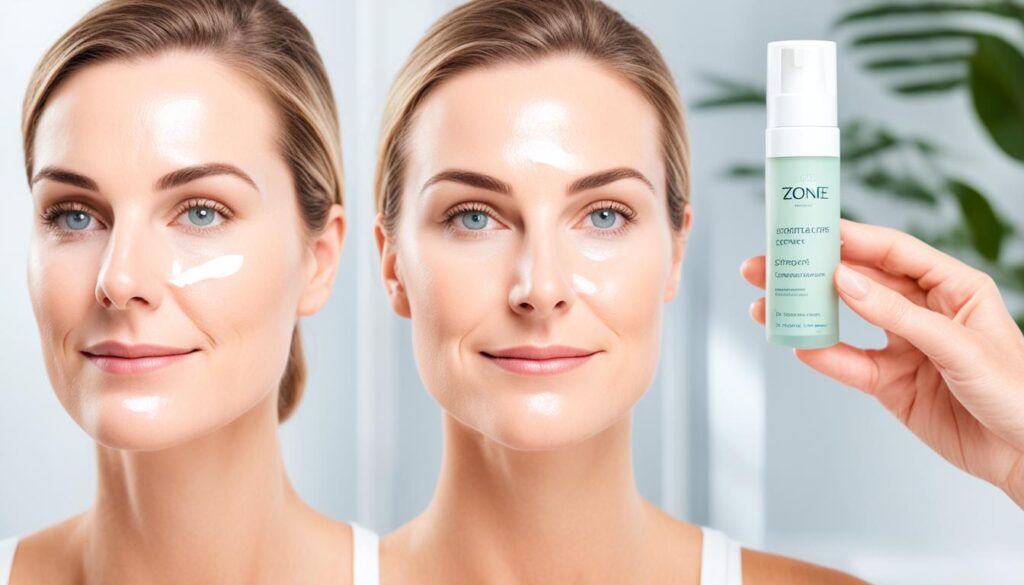Optimal Skincare Routine For Combination Skins

Skincare Routine For Combination Skins is a common skin type that exhibits both oily and dry areas. It requires a specific skincare routine to balance these different needs and achieve a radiant, healthy-looking complexion. Combination skin is characterized by an oily T-zone (forehead, nose, and chin) and dry or normal cheeks. It can also be associated with issues like enlarged pores, acne, and uneven skin texture. Creating an optimal skincare routine for combination skin involves cleansing, hydrating, and protecting the skin while addressing specific concerns. It is important to use products that are gentle, hydrating, and suitable for all skin types to maintain the skin’s natural balance and promote overall skin health.
Key Takeaways: Skincare Routine For Combination Skins
- Determine your skin type: Combination skin has both oily and dry areas, with an oily T-zone and dry or normal cheeks.
- Use gentle and hydrating products: Choose skincare products that are suitable for all skin types to maintain the skin’s balance.
- Cleanse, hydrate, and protect: Follow a skincare routine that includes cleansing, hydrating, and protecting the skin from harmful UV rays.
- Address specific concerns: Incorporate key ingredients like exfoliating acids, retinoids, and Vitamin C to address individual skin concerns such as acne, uneven texture, and dullness.
- Create a weekly facial routine: Include an exfoliating mask and a nourishing, hydrating mask to boost the results of daily skincare and promote a brighter, more hydrated complexion.
Understanding Combination Skin
Combination skin is a unique skin type that exhibits both oily and dry areas. The T-zone, which includes the forehead, nose, and chin, tends to be oily, while the cheeks and other peripheral areas of the face may be normal or dry. This can vary from mild oiliness in the T-zone with slight dryness on the cheeks to extreme oiliness in the T-zone and severe dryness on the rest of the face.
Common signs of combination skin include:
- Oily T-zone: The T-zone tends to produce excess oil, leading to a shiny appearance.
- Dry cheeks: The cheeks may feel tight and show signs of dryness.
- Clogged pores: Combination skin is prone to clogged pores and breakouts.
- Uneven skin texture: Combination skin may have noticeable variations in skin texture, with some areas feeling rough or bumpy.
Several factors contribute to the development of combination skin. Oil production is influenced by hormonal changes, diet, and external factors such as climate and pollution. Hormonal fluctuations can cause the skin’s oil production to fluctuate as well. Additionally, external factors like extreme weather conditions and harsh skincare treatments can lead to irritation and dehydration in combination skin.
Understanding your skin type is crucial in creating an effective combination skincare routine. Differentiating between oily, dry, and normal skin types allows you to address each area’s specific needs without overly stripping or over-moisturizing the skin. This helps to restore balance, improve skin health, and prevent common issues associated with combination skin.
Key Ingredients for Combination Skin

Incorporating key ingredients into your combination skincare routine can help address the specific needs of combination skin and improve its overall condition.
Exfoliating Acids
Exfoliating acids, such as alpha hydroxy acids (AHAs) and beta hydroxy acids (BHAs), are beneficial for regulating oil production, smoothing rough skin texture, and clearing pores. They work by gently exfoliating the outer layer of dead skin cells, revealing a healthier, more radiant complexion.
Retinoids
Retinoids, including prescription-strength options like Adapalene and Tretinoin, are essential for treating sun damage, reducing the appearance of fine lines and wrinkles, controlling oil production, and fading hyperpigmentation. They promote cell turnover and stimulate collagen production, resulting in improved skin texture and tone.
Vitamin C
Vitamin C is a powerful antioxidant that stimulates collagen production, brightens the skin, and improves overall skin tone. It also helps reduce the appearance of dark spots and hyperpigmentation, giving the skin a more even complexion.
Enzyme Exfoliants
Enzyme exfoliants, such as papain and bromelain, provide a gentler alternative to chemical exfoliation. They work by breaking down the proteins that hold dead skin cells together, resulting in smoother, softer skin without causing irritation.
Hydrating Acids
Hydrating acids like hyaluronic acid and polyglutamic acid attract water to the skin, keeping it hydrated without stripping away natural oils. They help maintain the skin’s moisture balance, preventing dryness in the cheeks while also controlling oiliness in the T-zone.
Niacinamide
Niacinamide is a versatile ingredient that brightens the skin, reduces the appearance of pores, and helps regulate oil production. It also has anti-inflammatory properties that can soothe and calm irritated skin.
Ceramides
Ceramides, which are naturally found in the skin, help balance oil production and keep the skin hydrated while protecting the skin barrier. They play a crucial role in maintaining the skin’s overall health and preventing moisture loss.
Choosing skincare products with these key ingredients can help address the specific concerns of combination skin and promote a balanced, healthy complexion.
Essential Steps in a Combination Skincare Routine

A combination skincare routine should focus on three essential steps: cleansing, hydrating, and protecting the skin. By incorporating these steps into your daily regimen, you can effectively address your specific skin concerns and achieve a healthier, more balanced complexion.
Cleansing
Proper cleansing is the first step in any skincare routine. It helps remove impurities, excess oil, and debris from the skin’s surface, allowing it to breathe and function optimally. For combination skin, it’s important to use a gentle cleanser that effectively cleans without stripping the skin of its natural oils. Look for products with balancing ingredients like witch hazel or green tea extract.
Hydrating
Hydration is key to maintaining the moisture balance of combination skin. It helps prevent dryness in the cheeks while also controlling oiliness in the T-zone. Use a lightweight moisturizer that contains hydrating actives such as hyaluronic acid or glycerin. These ingredients attract and retain moisture, keeping your skin plump and hydrated throughout the day.
In addition to your daily moisturizer, consider incorporating a hydrating serum or essence into your routine. These products contain a higher concentration of hydrating ingredients and can be layered underneath your moisturizer for an extra boost of hydration.
Protecting
Protecting your skin from the damaging effects of the sun is essential for all skin types, including combination skin. UV rays can cause premature aging, uneven skin tone, and other skin concerns. To protect your skin, use a broad-spectrum sunscreen with at least SPF 30. Look for oil-free formulas that won’t clog your pores or feel heavy on your skin.
Additionally, incorporating specific actives into your routine can target individual skin concerns such as pores, wrinkles, uneven tone, and dullness. Ingredients like niacinamide, retinol, and vitamin C can help address these concerns and improve the overall appearance of your skin.
Remember, consistency is key when it comes to skincare. Stick to your routine and give your skin time to adjust and show results. With a combination skincare routine that focuses on cleansing, hydrating, and protecting your skin, you can achieve a healthier, more balanced complexion and address your specific skin concerns.
| Step | Description |
|---|---|
| Cleansing | Remove impurities, excess oil, and debris from the skin’s surface. |
| Hydrating | Maintain the moisture balance of combination skin. |
| Protecting | Shield the skin from the damaging effects of the sun. |
Morning Skincare Routine for Combination Skin

Creating a proper morning skincare routine is essential for maintaining the health and balance of combination skin. This routine should focus on cleansing, treating specific skin concerns, moisturizing, and protecting the skin from environmental damage. Follow these steps to start your day with a radiant, hydrated complexion.
- Double cleanse: Begin by removing any makeup, pollutants, and impurities from the skin. Start with a cleansing oil or cleansing balm to effectively remove makeup, followed by a gentle morning cleanser to cleanse the skin without stripping away its natural oils.
- Treat with actives: After cleansing, address individual skin concerns with specific actives. Consider using a retinol serum or prescription retinoid like Adapalene or Tretinoin to treat sun damage, fine lines, and wrinkles.
- Moisturize: Hydrate the skin with an emollient moisturizer that locks in moisture and protects the skin barrier. Look for moisturizers containing hydrating ingredients like ceramides, polyglutamic acid, and hyaluronic acid.
- Address under eye concerns: Apply a hydrating under eye cream that contains retinol to help reduce the appearance of dark circles and smile line wrinkles. Alternatively, you can use a separate retinoid product and layer it with a hydrating eye cream or your night moisturizer.
This morning skincare routine for combination skin will help keep your skin hydrated, protected, and address specific concerns such as dark circles and smile line wrinkles. Remember to adjust the routine according to your skin’s needs and consult a dermatologist for personalized advice.
The Benefits of a Morning Skincare Routine for Combination Skin
By following a morning skincare routine tailored to combination skin, you can reap several benefits:
- Double cleansing ensures the removal of makeup and impurities, promoting a clean and refreshed complexion.
- Treating with actives like retinol can effectively target sun damage, fine lines, and wrinkles, improving the overall appearance of the skin.
- Moisturizing with an emollient moisturizer helps maintain hydration and protect the skin barrier, preventing dryness or excessive oiliness.
- Addressing under eye concerns, such as dark circles and smile line wrinkles, contributes to a youthful and vibrant look.
By incorporating these steps into your morning skincare routine, you can keep your combination skin looking its best throughout the day.
Also Read: Skincare Routine For Problematic Skin Essentials
Weekly Facial for Combination Skin
In addition to your daily skincare routine, incorporating a weekly facial can provide a more thorough treatment for combination skin, targeting specific concerns and repairing the skin barrier. The key to an effective weekly facial is to use a combination of active masks that contain resurfacing exfoliating acids and enzyme face masks.
Start with an active mask that contains a resurfacing exfoliating acid. This type of mask is designed to remove dead skin cells, smooth wrinkles and uneven texture, reduce the appearance of pores, and fade hyperpigmentation. Look for masks that contain potent ingredients like alpha hydroxy acids (AHAs) or beta hydroxy acids (BHAs) to deliver these skin-renewing benefits.
After using the exfoliating mask, follow up with a nourishing hydrating mask to replenish and hydrate the skin. Look for masks that contain hydrating ingredients like hyaluronic acid, peptides, vitamin C, and niacinamide. These ingredients are known for their ability to deeply hydrate the skin, promote collagen production, and brighten the complexion. By combining these masks in your weekly facial, you can resurface the skin while promoting a brighter and more hydrated appearance.
Incorporating a weekly facial into your skincare routine is a great way to boost the results and specifically address the concerns of combination skin. Remember to choose masks that contain hydrating ingredients like hyaluronic acid, peptides, vitamin C, and niacinamide to keep your skin healthy, radiant, and well-hydrated.
FAQs
Q: What is combination skin?
A: Combination skin is a type of skin that is characterized by having both oily areas (usually in the T-zone) and dry areas on the face.
Q: How can I care for combination skin?
A: To care for combination skin, it’s important to use products that can hydrate your skin without making it too oily or too dry. Look for products specifically designed for combination skin type.
Q: What should I avoid for combination skin?
A: Avoid using harsh products that can strip your skin of its natural oils, as well as products that can clog pores and cause breakouts on oily areas.
Q: How can I best manage acne with combination skin?
A: For acne-prone combination skin, it’s important to use products that can help control excess oil production without drying out the skin. Look for gentle acne-fighting ingredients like salicylic acid.
Q: What are the best skincare products for combination skin?
A: Look for products that can help balance the skin, such as lightweight moisturizers, oil-free serums, and gentle cleansers. It’s also important to use products that can help restore the skin barrier.
Q: How can I achieve clear skin with combination skin?
A: To achieve clear skin with combination skin, focus on a skincare routine that targets both oily and dry areas, includes exfoliation to unclog pores, and protects the skin from environmental stressors.
Q: How can I keep my skin looking and feeling its best with combination skin?
A: To keep your skin looking and feeling its best, make sure to cleanse gently, moisturize regularly, protect from UV damage, and listen to your skin’s changing needs throughout the seasons.





